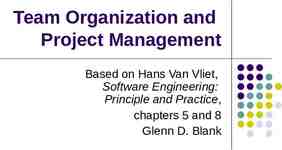Ethical and Social Issues in the Digital Firm (chapter 4)
53 Slides1,001.00 KB

Ethical and Social Issues in the Digital Firm (chapter 4)

UNDERSTANDING ETHICAL AND SOCIAL ISSUES RELATED TO SYSTEMS A New Legal and Social Environment In the past, so-called “white collar” crimes were treated with a slap on the wrist and fines to restore any damage done. Industrial societies have become much less tolerant of financial, accounting, and computer crimes. Since the late 1980s in the United States, and worldwide, legislation has been passed that mandates severe penalties for managers who are found guilty of a wide variety of financial, reporting, and computer crimes

UNDERSTANDING ETHICAL AND SOCIAL ISSUES RELATED TO SYSTEMS A New Legal and Social Environment (Continued) In the past, firms protected their managers by providing legal defense counsel. Today, however, in order to force employees to cooperate, prosecutors provide incentives to firms to not mount expensive legal defenses. Managers today will have to be especially careful in making ethical judgments.

UNDERSTANDING ETHICAL AND SOCIAL ISSUES RELATED TO SYSTEMS Ethics Principles of right and wrong Assumes individuals are acting as free moral agents to make choices to guide their behavior

UNDERSTANDING ETHICAL AND SOCIAL ISSUES RELATED TO SYSTEMS Information technology creates ethical issues because: (a) IT changes the distribution of decision-making rights, power and other resources. Example: IT makes it possible for millions of people to download video files, weakening the exclusive rights of movie studios to control distribution for their own profit.

UNDERSTANDING ETHICAL AND SOCIAL ISSUES RELATED TO SYSTEMS Information technology creates ethical issues because: (continued) (b) IT creates new opportunities to commit crimes. Example: E-mail creates the conditions for extensive “phishing” or online con games designed to defraud ordinary citizens.

UNDERSTANDING ETHICAL AND SOCIAL ISSUES RELATED TO SYSTEMS A Model for Thinking About Ethical, Social, and Political Issues Illustrates the dynamics connecting ethical, social, and political issues Identifies the moral dimensions of the “information society,” across individual, social, and political levels of action

UNDERSTANDING ETHICAL AND SOCIAL ISSUES RELATED TO SYSTEMS The Relationship between Ethical, Social, and Political Issues in an Information Society Figure 5-1

UNDERSTANDING ETHICAL AND SOCIAL ISSUES RELATED TO SYSTEMS Five Moral Dimensions of the Information Age Information rights and obligations (about ourselves, organization) Property rights and obligations (protection of intellectual property rights) Accountability and control (who will be held accountable if harm is done) System quality (standards of data and system quality) Quality of life (preservation of values, culture)

UNDERSTANDING ETHICAL AND SOCIAL ISSUES RELATED TO SYSTEMS Key Technology Trends that Raise Ethical Issues Changes in technology have some obvious positive consequences, but also create some potentially or actual negative consequences. Computing power doubles every 18 months: Dependence on computer systems increases, and it becomes more cost effective to process massive amounts of personal information.

UNDERSTANDING ETHICAL AND SOCIAL ISSUES RELATED TO SYSTEMS Key Technology Trends Raise Ethical Issues (Continued) Rapidly declining data storage costs: Lowers the cost of creating huge national databases composed of private information; lowers the cost of storing and using illegal music files Data-mining advances: Increases the ability of firms and governments to track the movement of citizens throughout life Networking advances and the Internet: Remotely accessing personal data

ETHICS IN AN INFORMATION SOCIETY Basic Concepts: Responsibility, Accountability, and Liability Responsibility: Accepting the potential costs, duties, and obligations for decisions Accountability: Mechanisms for identifying responsible parties Liability: Permits individuals (and firms) to recover damages done to them Due process: Laws are well known and understood, with an ability to appeal to higher authorities

ETHICS IN AN INFORMATION SOCIETY Ethical Analysis Identify and describe the facts Define the conflict or dilemma, the values involved Identify the stakeholders Identify the options Identify the consequences

Management Information Systems Chapter 5 Ethical and Social Issues in the Digital Firm ETHICS IN AN INFORMATION SOCIETY Some Real-World IT Ethical Dilemmas Using systems to increase efficiency, and causing layoffs and personal hardships Using systems to monitor employee e-mail to protect valuable assets, but decreasing employee privacy Monitoring employee use of the Internet at work, decreasing employee privacy

ETHICS IN AN INFORMATION SOCIETY Some Real-World IT Ethical Dilemmas (Continued) Using huge databases to aggregate consumer information, reducing the costs of granting credit, but increasing the chance of losing personal data to criminals, terrorists, or others What ethical principles can we use to analyze these situations?

ETHICS IN AN INFORMATION SOCIETY Candidate Ethical Principles Golden Rule: Do unto others as you would have them do unto you Immanuel Kant’s Categorical Imperative: If an action is not right for everyone to take, then it is not right for anyone Descartes’ rule of change: If an action cannot be taken repeatedly, then it is not right to be taken at any time

ETHICS IN AN INFORMATION SOCIETY Candidate Ethical Principles (Continued) Utilitarian Principle: Take the action that achieves the greatest value for all concerned Risk Aversion Principle: Take the action that produces the least harm or incurs the least cost to all concerned Ethical “no free lunch” rule: Assume that all tangible and intangible objects are owned by someone else, unless shown the contrary. If someone has created something of value to you, that person probably wants compensation for your use

ETHICS IN AN INFORMATION SOCIETY Professional Codes of Conduct Promises by professions to regulate themselves in the general interest of society Promulgated by associations such as the American Medical Association (AMA), and the American Bar Association (ABA)

ETHICS IN AN INFORMATION SOCIETY Ethics Codes for IT Professionals ACM Codes of Conduct http://www.acm.org/constitution/code.html Geographic Information System Professionals Code of Ethics IEEE Code of Ethics

ETHICS IN AN INFORMATION SOCIETY IEEE Code of Ethics We, the members of the IEEE, in recognition of the importance of our technologies in affecting the quality of life throughout the world, and in accepting a personal obligation to our profession, its members and the communities we serve, do hereby commit ourselves to the highest ethical and professional conduct and agree: 1. to accept responsibility in making decisions consistent with the safety, health and welfare of the public, and to disclose promptly factors that might endanger the public or the environment; 2. to avoid real or perceived conflicts of interest whenever possible, and to disclose them to affected parties when they do exist; 3. to be honest and realistic in stating claims or estimates based on available data; 4. to reject bribery in all its forms; 5. to improve the understanding of technology, its appropriate application, and potential consequences; 6. to maintain and improve our technical competence and to undertake technological tasks for others only if qualified by training or experience, or after full disclosure of pertinent limitations; 7. to seek, accept, and offer honest criticism of technical work, to acknowledge and correct errors, and to credit properly the contributions of others; 8. to treat fairly all persons regardless of such factors as race, religion, gender, disability, age, or national origin; 9. to avoid injuring others, their property, reputation, or employment by false or malicious action; 10. to assist colleagues and co-workers in their professional development and to support them in following this code of ethics.

THE MORAL DIMENSIONS OF INFORMATION SYSTEMS Information Rights: Privacy and Freedom in the Internet Age Privacy: Claim of individuals to be left alone, free from surveillance or interference from other individuals, organizations, or the state. The claim to be able to control information about yourself Fair information practices: Set of principles governing the collection and use of information on the basis of U.S. and European privacy laws. Based on mutuality of interest between record holder and the individual

THE MORAL DIMENSIONS OF INFORMATION SYSTEMS U.S. Federal Privacy Laws General federal privacy laws: Freedom of Information Act, 1966 Privacy Act of 1974 Electronic Communications Privacy Act of 1986 Computer Matching and Privacy Protection Act of 1988 Computer Security Act of 1987 Federal Managers Financial Integrity Act of 1982

THE MORAL DIMENSIONS OF INFORMATION SYSTEMS The Fair Information Practices Doctrine Developed in the early 1970s, FIP is the predominant U.S. doctrine. A set of principles governing the collection and use of information about individuals Notice/awareness (core principle) Choice/consent (core principle) Access/participation Security Enforcement

THE MORAL DIMENSIONS OF INFORMATION SYSTEMS The European Directive on Data Protection Informed consent: All uses of personal private information require the informed consent of data subjects, and require the data gatherer to provide the data subject with all facts needed to make a rational decision

THE MORAL DIMENSIONS OF INFORMATION SYSTEMS Data Protection Act Principles 1. 2. 3. 4. Personal data shall be processed fairly and lawfully Personal data shall be obtained only for one or more specified and lawful purposes, and shall not be further processed in any manner incompatible with that purpose or those purposes. Personal data shall be adequate, relevant and not excessive in relation to the purpose or purposes for which they are processed. Personal data shall be accurate and, where necessary, kept up to date.

THE MORAL DIMENSIONS OF INFORMATION SYSTEMS Data Protection Act Principles 5. 6. 7. 8. Personal data processed for any purpose or purposes shall not be kept for longer than is necessary for that purpose or those purposes. Personal data shall be processed in accordance with the rights of data subjects under this Act. Appropriate technical and organisational measures shall be taken against unauthorised or unlawful processing of personal data and against accidental loss or destruction of, or damage to, personal data. Personal data shall not be transferred to a country or territory outside the European Economic Area unless that country or territory ensures an adequate level of protection for the rights and freedoms of data subjects in relation to the processing of personal data.

THE MORAL DIMENSIONS OF INFORMATION SYSTEMS Conditions Relevant to the 1st Principle The data subject (the person whose data is stored) has consented ("given their permission") to the processing; Processing is necessary for 'the performance of a contract (any processing not directly required to complete a contract would not be "fair"); Processing is required under a legal obligation Processing is necessary to protect the vital interests of the data subject's rights; Processing is necessary to carry out any public functions; Processing is necessary in order to pursue the legitimate interests of the "data controller" or "third parties" (unless it could unjustifiably prejudice the interests of the data subject).

THE MORAL DIMENSIONS OF INFORMATION SYSTEMS Exemptions from the Data Protection Principles National Security Crime, Taxation

THE MORAL DIMENSIONS OF INFORMATION SYSTEMS Safe harbor: Private self-regulating policy and enforcement mechanism that meets the objectives of government regulators but does not involve government regulation or enforcement. Example: U.S. corporations doing business in Europe must process their data in a “safe harbor” where the European rules of privacy are in force “Safe harbor” status is granted by the EU after certification by a trusted third party, e.g. a recognized public account firm.

THE MORAL DIMENSIONS OF INFORMATION SYSTEMS Internet Challenges to Privacy Cookies: Tiny files deposited on a hard drive Used to identify the visitor and track visits to the Web site May or may not be used to gather personal private information In some cases, only a visitors customer number is maintained, not any personal information. In other cases, personal information can be gathered

THE MORAL DIMENSIONS OF INFORMATION SYSTEMS How Cookies Identify Web Visitors Figure 5-3

THE MORAL DIMENSIONS OF INFORMATION SYSTEMS Internet Challenges to Privacy Web bugs: Tiny graphic files embedded in e-mail messages and Web pages. When the user views the e-mail, or views the page, a message is sent to the server, or to a third-party server without the knowledge of the user. Designed to monitor online Internet user behavior. In the case of e-mail, the e-mail address is known to the server.

THE MORAL DIMENSIONS OF INFORMATION SYSTEMS Spyware: Software downloaded onto a user’s computer— usually without knowledge—that tracks Web behavior and reports that behavior to a third-party server Spyware is also used to call for ads from thirdparty servers, or to divert customers from one site to a preferred site. For example, you enter www.LLBean.com and the spyware program takes you to www.eddiebauer.com and displays a discount coupon for Eddie Bauer.

THE MORAL DIMENSIONS OF INFORMATION SYSTEMS Spyware: (Continued) LL Bean sued. The adware manufacturer Gator.com changed the software, and stopped the marketing campaign. They settled out of court. Typically downloaded by file-sharing programs like Kazaa, who make money selling advertising to large consumer products, retailing, and clothing companies.

THE MORAL DIMENSIONS OF INFORMATION SYSTEMS Two Models of Providing Web Privacy U.S. Opt-out model: Informed consent means permitting sites to collect personal information unless the user explicitly chooses to opt out by unclicking a box or taking some action. The default is to assume consent is given.

THE MORAL DIMENSIONS OF INFORMATION SYSTEMS European Opt-in model: Informed consent means prohibiting an organization from collecting any personal information unless the users specifically requests to allow such use by clicking a box. The default is to assume consent is not given. What do you think works best to protect the privacy of individuals?

THE MORAL DIMENSIONS OF INFORMATION SYSTEMS Technical Solutions P3P Platform for Privacy Preferences Project Industry standard designed to give users more control over personal information

THE MORAL DIMENSIONS OF INFORMATION SYSTEMS The P3P Standard Figure 5-4

THE MORAL DIMENSIONS OF INFORMATION SYSTEMS Ethical Issues Under what conditions should the privacy of others be invaded? What legitimates intruding into others’ lives through unobtrusive surveillance, through market research, or by whatever means? Do we have to inform people that we are eavesdropping? Do we have to inform people that we are using credit history information for employment screening purposes?

THE MORAL DIMENSIONS OF INFORMATION SYSTEMS Property Rights: Intellectual Property Intellectual property: Intangible property of any kind created by individuals or corporations Three main ways that intellectual property is protected: Trade secret: Intellectual work or product belonging to business, not in the public domain

THE MORAL DIMENSIONS OF INFORMATION SYSTEMS Property Rights: Intellectual Property Three main ways that intellectual property is protected: (Continued) Copyright: Statutory grant protecting intellectual property from being copied for the life of the author, plus 70 years Patents: A grant to the creator of an invention granting the owner an exclusive monopoly on the ideas behind an invention for 20 years

THE MORAL DIMENSIONS OF INFORMATION SYSTEMS Challenges to Intellectual Property Rights Perfect digital copies cost almost nothing. Sharing of digital content over the Internet costs almost nothing. Courts have generally not interfered with the commercialization of technology that creates perfect copies of protected works as long as the manufacturer could not control how customers use its products.

THE MORAL DIMENSIONS OF INFORMATION SYSTEMS Challenges to Intellectual Property Rights (Continued) Example: Publishers sued Xerox corporation because users copied books and magazines. The publishers lost. Example: The Motion Picture Industry Association sued Sony because users of its VCRs make illegal copies of Hollywood movies. MPIA lost. Question: what is an ethical solution to this dilemma?

THE MORAL DIMENSIONS OF INFORMATION SYSTEMS Who owns the pieces? Anatomy of a Web page Figure 5-5

THE MORAL DIMENSIONS OF INFORMATION SYSTEMS IT: Accountability, Liability, and Control IT can challenge our ability to identify who is responsible for actions involving systems that injure people. IT can make it difficult to assign liability and restore injured persons. IT raises issues about who should control information systems that have the potential for injuring citizens.

THE MORAL DIMENSIONS OF INFORMATION SYSTEMS IT: Accountability, Liability, and Control (Continued) Example: ChoicePoint.com is a leading provider of decision-making information to businesses and government agencies that helps reduce fraud and risk. It lost to criminal business firms 130,000 personal records of California residents in February 2005. This loss may result in the victims losing credit, being denied an apartment, losing employment, or experiencing an identity theft. What are the issues of accountability, liability, and control in this case?

THE MORAL DIMENSIONS OF INFORMATION SYSTEMS Ethics and System Quality: Data Quality and System Errors No software program is perfect, errors will be made, even if the errors have a low probability of occurring. Errors in Windows operating systems were notorious. At what point should software “be shipped?” What kind of disclaimer statements might be appropriate?

THE MORAL DIMENSIONS OF INFORMATION SYSTEMS Ethics and System Quality: Data Quality and System Errors (Continued) No database is without errors. In fact, most consumer and government personal information databases have errors ranging from 10-20% of the data records being either inaccurate, incomplete, or ambiguous. How should decision makers treat this kind of information in order to be fair to data subjects?

THE MORAL DIMENSIONS OF INFORMATION SYSTEMS IT and Quality of Life Issues: Equity, Access, and Boundaries Balancing Power: Center Versus Periphery: Is IT centralizing decision-making power in the hands of a few, or is it allowing many more people to participate in decisions that affect their lives? Rapidity of change: Reduced response time to competition: The business you work for may not be able to respond to rapidly changing IT-enabled market places. There goes your job offshore!

THE MORAL DIMENSIONS OF INFORMATION SYSTEMS IT and Quality of Life Issues: Equity, Access, and Boundaries (Continued) Maintaining boundaries: Family, work, and leisure: “Do anything anywhere” environment blurs the boundaries between work, vacation, and family time Dependence and vulnerability: There are few regulatory standards to protect us from the failure of complex electrical, communications, and computer networks upon which we all depend

THE MORAL DIMENSIONS OF INFORMATION SYSTEMS IT and Quality of Life Issues: Equity, Access, and Boundaries (Continued) Computer crime: Commission of illegal acts through the use of a computer or against a computer system is on the increase. Spam is now illegal (a federal and state felony offense), and phishing to defraud people is also a felony. But 70% of e-mail is now spam, and phishing crimes are the fastest growing Internet fraud. Computer abuse: Unethical but not necessarily illegal acts. Adware programs that alter a person’s browser are not illegal but most of us would not want this to happen (without knowing about it)

THE MORAL DIMENSIONS OF INFORMATION SYSTEMS IT and Quality of Life Issues: Equity, Access, and Boundaries (Continued) Employment: Trickle-down technology and reengineering job loss: The rapid development of the Internet has made it possible to offshore hundreds of thousands of jobs from high-wage countries to lowwage countries. Reengineering existing jobs using IT also results in few jobs (generally). While this benefits low-wage countries enormously, the costs are paid by high-wage country workers

MANAGEMENT OPPORTUNITIES, CHALLENGES, AND SOLUTIONS Solution Guidelines: Management should devise policies and ethical standards specifically for IT areas that cover the following: Information rights and obligations Property rights and obligations System quality Quality of life Accountability and control






